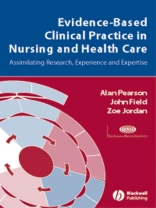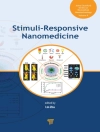Evidence-Based Clinical Practice in Nursing and Healthcare examines the Joanna Briggs Institute model for evidence-based practice which recognises research, theory and practice as sources of evidence and takes a practical approach to developing, implementing and evaluating practice, based on ’evidence’ in its broadest sense.
Evidence-based Clinical Practice in Nursing and Healthcare addresses the nature of evidence in clinical practice, generating and synthesising evidence, and transferring and utilising evidence in clinical practice. It describes the development of practice information sheets and clinical guidelines and provides practical guidance on the implementation of evidence-based practice and its evaluation using clinical audit.
Innehållsförteckning
Chapter 1: The Evolution Of Evidence Based Practice.
Introduction.
Evidence Based Health Care (Ebhc).
Evidence Based Medicine.
Evidence Based Practice Around The World.
Evidence Based Practice – Beyond Medicine.
A Multidisciplinary Affair.
The Roles Of Consumers.
Criticisms Of The Evidence Based Approach.
Getting Practical.
Conclusion.
Chapter 2: A Comprehensive Approach To Evidence Based Health Care: The JBI Model Of Evidence Based Health Care .
Introduction.
Health Care Evidence Generation.
Evidence Of ‘Feasibility’.
Evidence Of ‘Appropriateness’.
Evidence Of ‘Meaningfulness’.
Evidence Of ‘Effectiveness’.
Evidence Synthesis.
Evidence (Knowledge) Transfer.
Evidence Utilisation.
Conclusion.
Chapter 3: What Is Evidence For Practice?.
Introduction.
Feasibility, Appropriateness, Meaningfulness And Effectiveness.
Achieving A Balance Between Evidence Of Effectiveness And Other Evidence.
Interests For Clinicians And Consumers.
The Nature Of Evidence.
Evidence For Health Professionals.
Evidence For Health Consumers.
Conclusion.
What Does This Mean In Practical Terms?.
Chapter 4: Health Care Evidence Generation .
Introduction.
Guiding Paradigms In Research.
The Qualitative/Quantitative Debate.
Paradigm, Methodology And Method.
The Quantitative Research Approach.
The Interpretive Research Approach.
The Critical Research Approach.
Sources For Evidence Of Feasibility.
Sources For Evidence Of Appropriateness.
Sources For Evidence Of Meaningfulness.
Sources For Evidence Of Effectiveness.
Conclusion.
Chapter 5: Evidence Synthesis: The Systematic Review .
Introduction.
Overview Of The Systematic Review Process.
The Importance Of Systematic Reviews Of Evidence.
Finding The Evidence.
Study Selection.
Conclusion.
In Practice….
Chapter 6: Evidence Synthesis: Critical Appraisal, Data Extraction and the Synthesis Of Findings.
Introduction.
Critical Appraisal Of Evidence.
The Limitations Of Critical Appraisal.
Data Extraction.
Data Analysis And Synthesis.
Practical Tools For Systematic Reviews.
Conclusion.
Chapter 7: Evidence Transfer: Writing Up a Systematic Review Report and Developing Clinical Guidelines.
Introduction.
The Purpose Of The Systematic Review Report.
Writing The Report.
What Is A Clinical Guideline?.
Medicine Specific Guidelines.
Nursing Specific Clinical Guidelines.
Allied Health Specific Guidelines.
‘Consensus’ Versus ‘Evidence’.
Strategies For Guideline Development.
The Quality Of The Evidence.
Grades Of Recommendation.
Consumer Involvement In Guideline Development.
Guideline Appraisal.
The Role Of Guidelines In Practice.
Practical Tools For Guideline Development.
Conclusion.
Chapter 8: Evidence Utilisation: Implementing Evidence Based Guidelines .
Introduction.
Barriers To Change.
Changing Practice.
Evidence Based Health Care And Practice Change.
The Theory Behind Change.
A Process For Change.
Tools And Strategies.
Models For Change.
Knowledge Translation.
Evaluation.
Conclusion.
Chapter 9: Evidence Utilisation: Clinical Audit .
Introduction.
Clinical Effectiveness.
Clinical Audit.
Benefits Of Clinical Audit.
The Clinical Audit Process.
Strategies To Promote Successful Auditing.
Writing An Audit Report.
Practical Tools For Clinical Audit.
Clinical Audit And Research.
Conclusion.
Chapter 10: Evidence Based Practice – Issues And Challenges.
Introduction.
Evidence Based Practice And The Role Of Organisations.
Legal And Policy Implications Of Evidence Based Practice.
Health Care Takes The Lead … And Others Follow.
Consumer Participation.
The Rise And Rise Of Information Technology.
Conclusion.
References.
Appendices
Om författaren
Alan Pearson and Zoe Jordan are based at the Joanna Briggs Institute, Adelaide, Australia. John Field is based as James Cook University.












